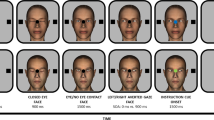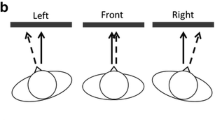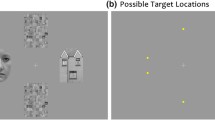Abstract
The purpose of the present study was to establish whether the validity effect produced by masked eye gaze cues should be attributed to strictly reflexive mechanisms or to volitional top-down mechanisms. While we find that masked eye gaze cues are effective in producing a validity effect in a central cueing paradigm, we also find that the efficacy of masked gaze cues is sharply constrained by the experimental context. Specifically, masked gaze cues only produced a validity effect when they appeared in the context of unmasked and predictive gaze cues. Unmasked gaze cues, in contrast, produced reliable validity effects across a range of experimental contexts, including Experiment 4 where 80% of the cues were invalid (counter-predictive). Taken together, these results suggest that the effective processing of masked gaze cues requires volitional control, whereas the processing of unmasked (clearly visible) gaze cues appears to benefit from both reflexive and top-down mechanisms.





Similar content being viewed by others
References
Adams RB, Kleck RE (2005) Effects of direct and averted gaze on the perception of facially communicated emotion. Emotion 5(1):3–11
Ansorge U, Neumann O (2005) Intentions determine the effect of invisible metacontrast-masked primes: evidence for top-down contingencies in a peripheral cueing task. J Exp Psychol Hum Percept Perform 31(4):762–777
Baayen RH, Davidson D, Bates D (2008) Mixed-effects modeling with crossed random effects for subjects and items. J Mem Lang 59:390–412
Bates D (2005) Fitting linear mixed models in R. R News 5:27–30
Bayliss AP, Bartlett J, Naughtin CK, Kritikos A (2010) A direct link between gaze perception and social attention. J Exp Psychol Hum Percept Perform 37(3):634–644
Bentin S, Sagiv N, Mecklinger A, Friederici A, von Cramon YD (2002) Piming visual face-processing mechanisms: electrophysiological evidence. Psychol Sci 13(2):190–193
Dehaene S, Naccache L, Le Clec GH, Koechlin E, Mueller M, Dehaene-Lambertz G, van de Mooretele P, Le Bihan D (1998) Imaging unconscious semantic priming. Nature 395:597–600
Driver J, Davis G, Ricciardelli P, Kidd P, Maxwell E, Baron-Cohen S (1999) Gaze perception triggers reflexive visuospatial orienting. Vis Cognit 6(5):509–540
Farroni T, Johnson MH, Brockbank M, Simion F (2000) Infants’ use of gaze direction to cue attention: the importance of perceived motion. Vis Cognit 7:705–718
Farroni T, Csibra G, Simion F, Johnson MH (2002) Eye contact detection in humans from birth. PNAS 99(14):9602–9605
Finkbeiner M, Friedman J (2011) The flexibility of nonconsciously deployed cognitive processes: evidence from masked congruence priming. PLoS One 6(2):e17095
Friesen CK, Kingstone A (1998) The eyes have it! Reflexive orienting is triggered by nonpredictive gaze. Psychon Bull Rev 5(3):490–495
Friesen CK, Ristic J, Kingstone A (2004) Attentional effects of counterpredictive gaze and arrow cues. J Exp Psychol Hum Percept Perform 30(2):319–329
George N, Conty L (2008) Facing the gaze of others. Clin Neurophysiol 38:197–207. doi:10.1016/j.neucli.2008.03.001
Hood BM, Willen JD, Driver J (1998) Adult’s eyes trigger shifts of visual attention in human infants. Psychol Sci 9:53–56
Kiesel A, Kunde W, Pohl C, Hoffmann J (2006) Priming from novel masked stimuli depends on target set size. Adv Cognit Psychol 2(1):37–45
Kunde W, Kiesel A, Hoffmann J (2003) Conscious control over the content of unconscious cognition. Cognition 88:223–242
Langton SRH, Bruce V (1999) Reflexive social orienting. Vis Cognit 6:541–567
Langton SRH, Roger JW, Bruce V (2000) Do the eyes have it? Dues to the direction of social attention. Trend Cognit Sci 4(2):50–59
Logan TT, David MS (2011) Neurobehavioural correlates of the rapid formation of the symbolic control of visuospatial attention. Psychphysiology 48(3):1–15
Reuss H, Pohl C, Kiesel A, Kunde W (in press) Follow the sign! Top-down contingent attentional capture of masked arrow cues. Adv Cognit Psychol
Ristic J, Kingstone A (2005) Taking control of reflexive social attention. Cognition 94:B55–B65
Ristic J, Kingstone A (2006) Attention to arrows: pointing to a new direction. Q J Exp Psychol 59(11):1921–1930
Ristic J, Friesen CK, Kingstone A (2002) Are eyes special? It depends on how you look at it. Psychon Bull Rev 9:507–513
Sato W, Okada T, Toichi M (2007) Attentional shift by gaze is triggered without awareness. Exp Brain Res 183:87–94
Tipples J (2002) Eye gaze is not unique: automatic orienting in response to uninformative arrows. Psychon Bull Rev 9(2):314–318
Van Gaal S, Lamme VA (2011) Unconscious high-level information processing: implication for neurobiological theories of consciousness. Neuroscientist 31:1–15
Acknowledgments
This work was supported in part by an Australian Research Fellowship to MF from the Australian Research Council (DP0880806).
Author information
Authors and Affiliations
Corresponding author
Rights and permissions
About this article
Cite this article
Al-Janabi, S., Finkbeiner, M. Effective processing of masked eye gaze requires volitional control. Exp Brain Res 216, 433–443 (2012). https://doi.org/10.1007/s00221-011-2944-0
Received:
Accepted:
Published:
Issue Date:
DOI: https://doi.org/10.1007/s00221-011-2944-0




